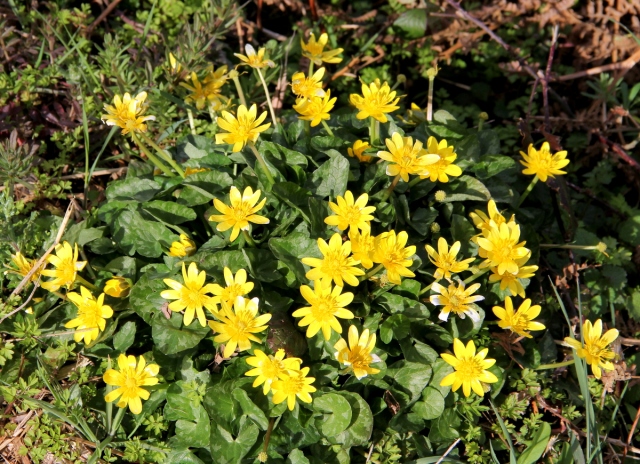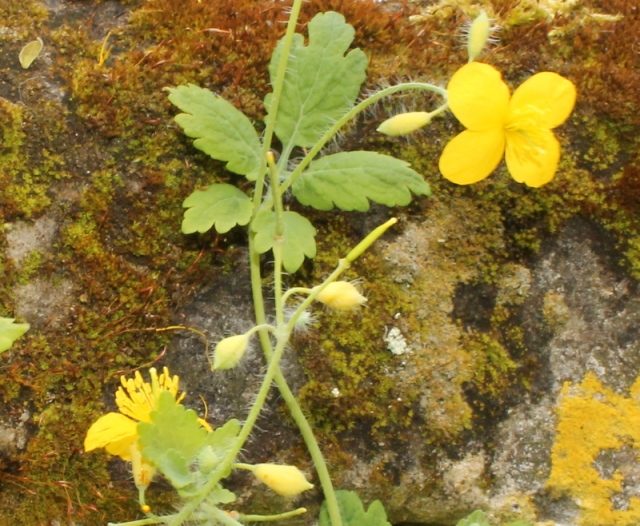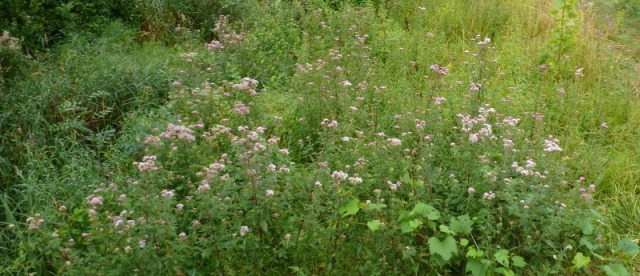I recall when I was very young often asking my father the names of various plants, specially the flowers of the beautiful wild weeds in the garden. I remember him looking at me and saying: “Why do you call them weeds? They are only another pretty flower that as yet we do not know their names.”
In our garden in France we do not to use chemical pesticides, and as much as possible we have learnt to live with the wild flowers. There are patches, specially near the river bed that all sorts of wild plants grow. They seem to add some special charm to the rustic nature of our garden.
There are, nevertheless a number of plants that I have systematically pulled out, as they tend to become invasive. One such weed is a little green plant with yellow flower that often grows in the crack of the walls. It is pretty whilst it is in flower and is still small, but the plant soon seems to grow smothering anything else around it.
A couple of weeks ago when, in Amelia’s absence, I visited the Fête de Printemps at the neighbouring village, I noticed that one nursery lady had potted the very same plant and was selling them, each at 4 Euros! I learnt that the little plant is called in French chélidoine, or the Chelidonium majus (greater celandine).
This plant does have a confusing name, as the greater celandine actually belongs to the poppy family, whereas the lesser celandine which frequently grows along the paths in early spring belongs to the buttercup family. We have a clump of lesser celandine at the bottom of the garden which attracts a lot of bees and butterflies in the early spring, much to Amelia’s delight.

The orange colour juice (the latex) oozing out of the cut stems has been used throughout centuries for the treatment of warts, giving the common name of the plant as tetterwort. Different parts of the plant have numerous pharmacological properties. It is said to be analgesic, and the latex has also been used to cauterize small wounds.

The greater celandine is considered toxic and should be handled with a little care as it might be allergenic and cause dermatitis. Nevertheless, I will not dig this little plant as ruthlessly as I used to do and remembering what my father told me, I have yet again gained greater respect for the weeds that often I do not know their names.




I am afraid the greater celandine gets pulled here as it is one of four really thuggish invaders in my garden. But the lesser celandine is far better behaved and very welcome. I am amazed she was selling the former! Those pots should come with a health warning!
LikeLike
I would not also pay 4 Euros for that flower. It is the supply and demand and there must be a demand for that plant.
Amelia has deliberately allowed the lesser celandine to grow in a corner of the garden near the river. So, I will also allow a few of the “thugs” nestle quietly in one or two corners in the garden – health warning and all. – K
LikeLike
Weeds, flowers, pollinator attractors,… beautiful additions, no matter what you call them. And if they’re worth 4 Euro each – all the better!
LikeLike
You know, when we look at a work of art, a painting by a famous artist, we know that people are prepared to pay tens of thousands or more for the work. And yet the flowers around us are often more beautiful than any painting. Why should we not pay, what is after all the price of one or two cups of coffee, for that “work of art” of nature. – K
LikeLike
I am astounded that anyone thought they could charge 4€ for Greater Celandine!! They are one of the few plants that gets pulled out in my garden too, but since I am such an intermittent and random gardener, they are in no danger of extirpation.
LikeLike
We need, perhaps, to learn to live and let live. In France, I was assured that the folk in the country do use the latex of the plant for the treatment of warts. So, if she charges 4 euros, I assume that is what people are prepared to pay.
On the other hands there are plenty of wild flowers in the woodlands around us [Solomon’s seal; Dicentra (Coeur-de-marie in French), Asphodèle, etc. They are all fantastic flowers, but nobody here seems willing to pay for them. – K
LikeLike
I’ve been told people use the sap to burn off warts too, and I’m sure it’s true, just as people used euphorbia sap where I grew up to zap incipient skin cancers. I just don’t believe that anyone in France would pay 4€ for a plant that grows everywhere. However, at least it isn’t likely to have been dug up from the wild.
It is one of the nice surprises of this area how many flowers in the woods are plants that we think of as garden plants, but here are native and wild.
LikeLike
Susan…
if Gamm Vert can charge 5€ for ONE Red Russian Kale, or a Black Tuscan Kale or a Ruby Chard plant…
this lady’s price for one Gurter Celandine was cheap!
Currently a packet of each of the above vegetables is in the region of £2 a packet…
our packet of Red Russian Kale promised over 150 plants….
reminds me… must plant some…
hold on a darned second…
there’s money to be made here!!
K… it is interesting to “look” at your garden through another pair of eyes. Thanks…
LikeLike
You are absolutely right. Plants from nurseries can be rather expensive. Mind you last year I decided to buy cucumber seeds in the UK, but when I read the package carefully in France, it contained 6 seeds!
Good luck with the planting. – K
LikeLike
We have greater celandine here too. Some of the most breath taking displays of flowers that I’ve seen were fields of “weeds.”
LikeLike
You are so absolutely right. Each time that I walk in the fields and the woods around our house I am astonished to see the beauty of the wild flowers that grow in abundance. – K
LikeLike
I, too, am a lover of pretty weeds and only pull them out — often with some regret — when they threaten to overtake the flowers in a bed.
LikeLike
Thank you for sharing my sentiments. I suppose, as my father reminded me, what is after all a weed? – K
LikeLike
I’m very tolerant of ‘weeds’ in our garden, and will often let something unfamiliar grow and flower before I decide whether to yank it out. I think that makes for a more interesting garden! 😉
LikeLike
I am so glad that you are so tolerant. There are weeds that become invasive. But there are also many “flowers” that also can overtake a border. Last year Amelia spent a lot of time digging out loads of Anemone hupehensis (Japanese windflower). The flower was given to us a couple of years earlier, but they seemed to take over two of our borders. – K
LikeLike
Someone once told me that weeds were just flowers growing in the wrong place. And someone else suggested that they are the first cultivators of the land; the ones who start to heal the bare earth and prepare it for a richer cultivation.
LikeLike
Thank you. I really like that. Such a wise suggestion by someone that has appreciated the purpose behind all wild things – K
LikeLike
I always go by the rule that a weed is only a plant growing where we don’t want it. So when I edit plants in the garden it is on this basis. So some ‘weeds’ stay in some places but not in others . Christina
LikeLike
Thank you, Christina. I like your rule of thumb. Specially in the country gardens such as in France or Italy, we should make space for nature to take its own course. I heard it once said that “weeds happen, because life happens.” – K
LikeLike
A weed is just a nice plant in the wrong place, somebody say. But that doesn’t go for the completely invasive ones. maybe you could sell some? 😉 In my garden plants just started growing, espescially the weeds….
LikeLike
Thank you. I agree with your sentiments. But I would not want to sell those little gems! – K
LikeLike
What a beautiful post – I’ve always had a fondness for ‘weeds’, hidden gems of every wildflower garden!
LikeLike
Emma, that is a very kind and thoughtful comment. I sometimes think that the weeds are there to remind us that although we’ve bought the garden, the earth does not belong to us. They were there before us, and we need to learn how to share our garden with them. – K [Amelia’s husband]
LikeLike
I really like that sentiment – will have to write it down and refer to it now and then…
LikeLike
I thought it might be useful for you to know that rubbing greater celandine leaves and flowers on a bee sting, in me anyway, stops the large and painful bump from forming. You have to apply it quickly though and NOT near eyes, mouth or nostrils i.e. Where mucous can carry the biting latex inwards.
LikeLike
I did not know that! I always have some nearby so I will make a mental note. I had noticed the orange latex and showed my granddaughter how to tattoo herself using a broken stem. It was a great success. Amelia
LikeLike